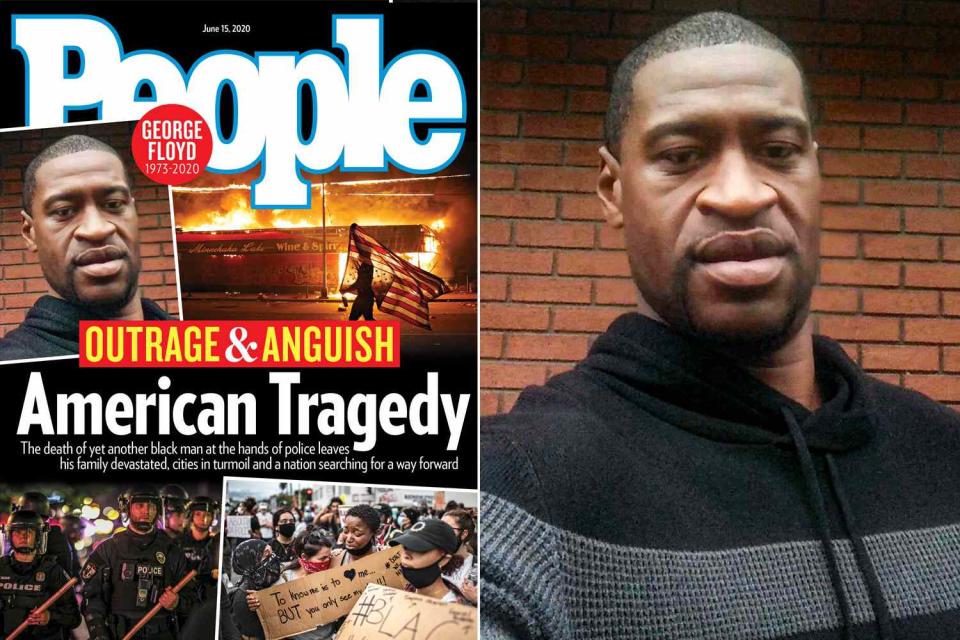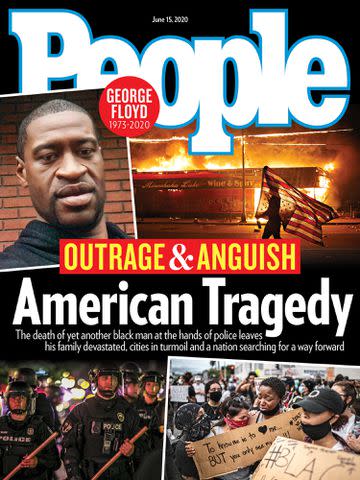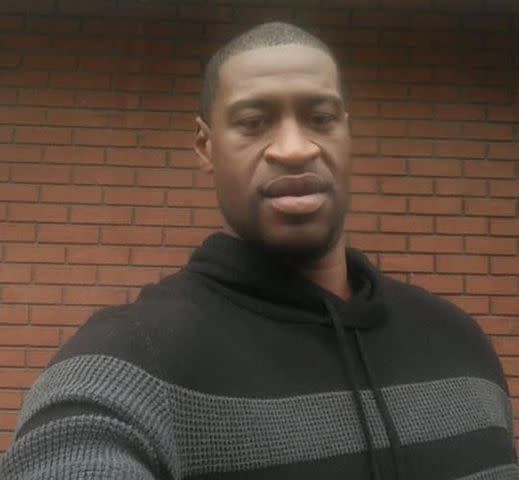Anguish in America: A Nation Torn Apart — Read PEOPLE's 2020 Cover Story 4 Years After George Floyd's Murder
Handcuffed—and begging for his life—George Floyd died four years ago with a police officer’s knee on his neck, sending thousands into the streets in protest

‘I can’t breathe.’ Facedown on the asphalt in downtown Minneapolis May 25, 46-year-old George Floyd pleaded for his life as he lay handcuffed, the knee of police officer Derek Chauvin pushing into the right side of his neck. “Please.” “I can’t breathe.” “Don’t kill me.” “Mama.”
For eight minutes, 46 seconds, Floyd, who was being arrested for allegedly using a counterfeit $20 bill, lay pressed against the pavement, even as multiple bystanders begged Chauvin and the other police officers participating in the arrest—J. Alexander Kueng, Thomas Lane and Tou Thao—to respond to Floyd’s obvious distress. Even after Floyd stops moving (4 minutes, 46 seconds). Even after Floyd stops speaking (5 minutes, 53 seconds). Even after Lane asks, “Want to roll him on his side?” Even after Kueng checks Floyd’s right wrist for a pulse and says, “I couldn’t find one.” Chauvin’s knee remains. It isn’t until an ambulance arrives and responders bend over an immobile Floyd that Chauvin removes his knee from Floyd’s neck.
Related: 2 Years After George Floyd Was Murdered by a Police Officer, His Sister Still 'Feels His Spirit'
The shattering video evidence of a man losing his life in the custody of the very people sworn to serve and protect him quickly sickened and enraged the millions who saw it. The day after the incident, Minneapolis police chief Medaria Arradondo fired all the officers. By May 29 Chauvin, 44, was under arrest, charged with manslaughter and third-degree murder; he is being held on $500,000 bond and has yet to enter a plea. More charges may be forthcoming. While an investigation into the actions of the other officers remains ongoing—“We felt it appropriate to focus on the most dangerous perpetrator,” Hennepin County Attorney Mike Freeman said May 29—the FBI has also launched a civil rights investigation into Floyd’s death. A somber Arradondo told CNN while visiting the spot where Floyd’s death occurred, “Being silent or not intervening, to me, you’re complicit, so I don’t see a level of distinction any different.... Mr. Floyd died in our hands.”

Related: Powerful Images from Protests Across the U.S. Over George Floyd's Death
That tragedy alone might have been enough to spark what followed—but sadly it wasn’t alone. On March 13 Breonna Taylor, 26, an EMT and emergency-room technician, was killed in her Louisville apartment when police served a “no knock” warrant and shot her when her boyfriend fired his own permitted weapon, fearing for his life. And on Feb. 23 Ahmaud Arbery, 25, was out jogging when he was killed by white men who said they suspected him of burglary near their home in Glynn County, Ga. Floyd’s death in their wake pushed the nation’s long-simmering racial tensions to a breaking point. Protesters took to the streets of Minneapolis and more than 100 American cities to express fear, outrage, despair and anger. Soon peaceful marches turned violent, with police cars set aflame and buildings vandalized and looted around the country. Rioters started fires in front of the White House, curfews were imposed in 40 cities, and National Guard troops were called in to restore order in at least 23 states.
Want to keep up with the latest crime coverage? Sign up for PEOPLE's free True Crime newsletter for breaking crime news, ongoing trial coverage and details of intriguing unsolved cases.
Those who knew George Floyd—“Big Floyd” to his friends—say the former security guard and nightclub bouncer would have been horrified by the violence taking place in his name. “He would have shut it down,” says his childhood friend Christopher Harris, 45. “He wouldn’t have stood for that. If people knew him, nothing would have burned. He wouldn’t want that. He wanted to protect everybody.”
For Alicia Smith, 36, a black Minneapolis community activist who had met Floyd a few times through a mutual friend, the circumstances of his death—and hearing him call out “Mama” with his final breaths—brings her to her knees. “You see the video, and you see an adult man that could be your father, your uncle, your brother,” says Smith, the mother of two boys, ages 11 and 7. “What I saw was my son. What I heard when I saw him scream out and call for his mother, I heard my son calling my name and begging for help. That sound, as a mother, rang so true to me.” Smith struggles with how to show her sons to protest peacefully, how to be safe. “My 11-year-old son asked me, ‘Is someone going to kill me too?’ How do you explain that? So I have to chip away at his innocence by preparing him to exist in this world as a black man when he’s just a little boy.”
But Smith says she is determined to stand up against the injustice that took Floyd’s life—and the lives of so many others. “We’re going to continue to fight until we all can have equal access to be able to walk down the street, jog, laugh, dine, drive, walk in the park, sit on the front porches at the house,” she says. “I’d only met George in passing. We exchanged some salutations. But most importantly, I know millions of Georges. I would like for this to never happen again.”
As the nation struggles to find a path to healing, people around the U.S. share their experiences:

Trae Tha Truth, 39, Houston rapper and longtime friend of George Floyd
George would always try to make the best of situations. He would be saying, “Hey, naw, this ain’t the way to go about it. This is not cool.” A lot of the younger ones looked at him as O.G. status, somebody they would actually respect and listen to. It’s heartbreaking for this situation to occur. But it’s a good thing that he’s sparking change.
One thing I know: He would stand up if it would happen to one of us. Us standing up now is to protect our kids in the future. A lot of people feel that black lives are less than any other life, and that’s not the case. We matter too. And we’re going to fight for it.
Related: George Floyd's Sister Says Trial Reminds Her of Suffering He Endured: 'He Felt Every Ounce of Pain'
Charles Stotts, 50, owner, with wife Kacey White, of Minneapolis’s Town Talk Diner
Tuesday night was the first protest here. And our restaurant is—was—about 150 yards from the Third Precinct. We went down there just to, you know, be a part of it. It was what I would call peaceful protesting. Wednesday we noticed that the police were putting up concrete barricades around the precinct building. [An] officer said, “You should grab your valuables and board up your windows and get out.” Thursday night at around 5 p.m. there was one of the most amazing, peaceful protests outside the Third Precinct. It was exactly what a protest was supposed to be. It made you feel good. It was enlightening. And I remember as we left I said to Kacey, “Last night was the turning point.”
Then around 4:30 in the morning Kasey’s phone dings, and it’s a text from a friend of ours: “Your building’s on fire.” It is really heartbreaking. We’ve got our lives tied into that restaurant; it’s literally everything.... It’s really, really hard. A lot of healing needs to happen in Minneapolis. Anybody asks me, “What can I do?” my answer is you can pray for the family of George Floyd. The focus still needs to remain on the fact that there’s a gentleman that should still be with us on this planet, and he’s not.
Art Acevedo, 55, Houston police chief, who has been marching with protesters
I wish people who don’t understand the righteous anger of so many people of color, I wish they could walk with me with the protesters. So they can hear with their own ears, and see with their own eyes, the deep pain that especially African-American communities are feeling. Just watching that video, if you don’t have indignation, if you try to justify what happened to George Floyd in any manner, then you are the problem. It has been a life-altering experience to actually come out and support a community that truly is hurting. I will take these memories with me to the grave.
Brad Lloyd, 37, a fitness trainer who attended protests in Brooklyn
Hundreds of people... I saw, like, a line of white people just sitting down, creating a barricade. So [police] couldn’t go down the one-way street. So they had to turn and go the other way. And then you saw some black people behind them. And I’m standing right here witnessing the whole thing, the whole time. And I’m like, “Hell yeah. That’s what I’m talking about.” To me, that just says you actually are trying to make a difference for your fellow brother of color.
Tanness Walker, 23, community activist who attended the May 30 march in Los Angeles
We were having protesters talk about their experiences with police and their experiences with injustice. Then the crowd started to move.... The cops came, and they was barricading everyone, throwing tear gas. They parked the cars in the middle of the street and wouldn’t let us through. My brother and one of his friends got hit with the rubber bullets. I got pushed down with a baton when I was trying to leave. It was mayhem. As we left, the looting started. People shouldn’t loot.... It’s happening because these people are mad. But people look at the looters—“Oh, it’s just a bunch of black people looting”—and the message kind of gets lost.... Chanting for George Floyd, wanting justice for him, that needs to be clear. We need to fight for that.
Related: George Floyd's Aunt Angela Harrelson Is Writing a Book: 'He Wanted the World to Hear His Voice'
Mawuli Davis, 51, civil rights attorney who attended Atlanta protests with his sons Kobie, 22, and Khari, 20
I was up on the parking garage when the police car was set on fire and vandalized. I saw that, and I immediately tried to get down into the crowd and find my sons so we could get out. I knew that things had gone in a direction that was not safe. The young people that were down there, they came for their voices to be heard, but they don’t need to be hurt or killed or arrested and have their entire life change. They’re angry. And they have something to say. They’re saying it in the language you may not hear in church. But they’re saying what they have to say. It’s been a very intense situation. Very intense, very volatile. One of my sons described it as surreal. In almost 30 years of organizing, I’ve never seen a police car set on fire.
Olga Hall, 43, a nurse, and her son Tim, 28, a medical office assistant, who attended a Washington, D.C., protest May 30
Olga: There was electricity in the air. Everybody was there for the same purpose. There were people handing out free cloth masks and free water and snacks. The feeling of camaraderie among the protesters, it filled my heart.
After 10 p.m. a new crowd came in, an angrier crowd. Things started to escalate. You got people climbing up the traffic lights and throwing water bottles and stuff at the police. And the police threw out pepper spray, and things deteriorated from there. People throwing things, bashing windows in, which speaks to the rage that people are feeling.
Tim: I had an experience with the police almost two months ago. They busted into my house and had my mom at gunpoint, and—and it’s not like I did anything. [Police later admitted they had the wrong house.] That didn’t make any sense to me. No sense. Then we’re out yesterday, we are peacefully protesting, and they had the nerve to put gas in the air to make us cough and choke when we have a pandemic going on that’s already an airborne illness. It got really, really angry. Really angry. There was a lot of stuff on fire. Glass breaking. The protest last night needed to happen.
Reneé Hall, 49, Dallas police chief, who cleared the streets on May 29 for protesters to march
People who are 60 remember the days of water hoses being sicced on them by law enforcement, so when these actions surface, even by a small number of members of law enforcement, they look at it as a culture that still exists in the police department. We understand that there have been multiple deaths of unarmed black men at the hands of law enforcement. I acknowledge that. It doesn’t represent all of law enforcement. We are all outraged.
So it was so important for us to say we respect peaceful protests. We will also make sure that no hurt or harm comes to you as you peacefully express your concerns. We stand with you in acknowledging the wrong—and working to fix it.
Related: George Floyd Memorial Photos from the One-Year Anniversary
Amir McRae, 40, owner of ATL Cruzers, a Segway tour business in Atlanta, and a father of three
I was woken early Saturday by an alarm call at 12:40 a.m. I went downtown, and it was just people everywhere, in and out of the convenience store next to [my business]. My adrenaline was pumping, and I asked people to stop looting. We’ve been in a pandemic, and businesses are hit hard. I helped board up the other businesses, protect the assets. I’ve seen people, young people and older people, just walking around with the right mindset of peaceful protest. I’ve seen some really tough things to watch for our community, which is broken glass and buildings that have been trampled and tear gas and fireworks. I’ve seen a lot. I went and really risked my life through conversation with looters at a business that I don’t own. I’m about making sure that we all do this the right way.
Reporting by ELAINE ARADILLAS, K.C. BAKER, DIANE HERBST, WENDY GROSSMAN KANTOR, SUSAN KATZ KEATING, CHRISTINE PELISEK and JEFF TRUESDELL
For more People news, make sure to sign up for our newsletter!
Read the original article on People.


